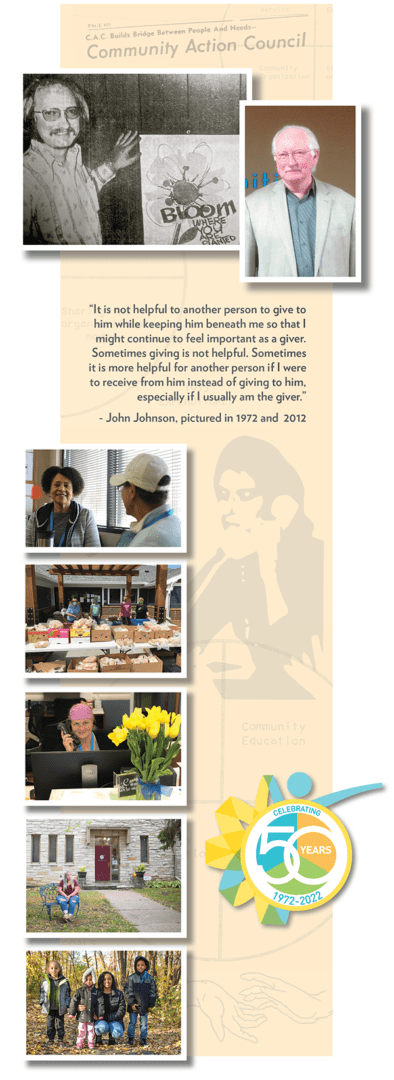 From our beginning, committed volunteers achieved significant impacts by pooling resources, building connections with their neighbors, and addressing the needs in their community. Today, 360 Communities still serves as a center of giving, receiving, and caring as community members ensure hope for the future.
From our beginning, committed volunteers achieved significant impacts by pooling resources, building connections with their neighbors, and addressing the needs in their community. Today, 360 Communities still serves as a center of giving, receiving, and caring as community members ensure hope for the future.
How it began
In 1970, the Social Action Committee at Church of the Risen Savior used a blackboard to list area needs. They quickly realized that the impact as a committee of five would not be enough. So, they spoke with other churches to explore collaboration and resource sharing. Through these conversations, they were introduced to John Johnson, who came to the area with the mission of establishing a non-traditional ministry. This “experiment” in developing social action began with John Johnson as director of a collaborative project focused on sharing resources and meeting community needs.
Critical mass
Throughout 1971, 28 churches from Lakeville, Farmington, Burnsville, Rosemount, Eagan, and Apple Valley engaged in this project with social action and volunteerism, calling themselves the Community Action Council. Early activities involved the compilation of a manual containing all human service resources available to people in Dakota County, and the creation of an information and referral line to assist residents connecting with these resources. This referral line was set up as 432-5663, which on the telephone dial spells IF-A-LONE. If someone needed help or felt isolated, they dialed IF-A-LONE to be connected with a caring individual from their community who was ready to listen and provide support. Needs from people seeking help were heard, and with them, supportive programs were created by individuals who cared.
It’s official
In 1972, the Community Action Council was incorporated under a formal 501c3 organizational structure with a focus on providing community service and education. In 2010, Community Action Council rebranded, choosing the name 360 Communities to represent the circle of giving and receiving experienced daily between volunteers, donors, and people seeking support, and to represent our holistic approach to delivering services.
Today, 360 Communities continues to innovate and evolve, but we never lost sight of the heart of our work: relationships. Although the way we relate to each other through technology is vastly different from 50 years ago, the human condition, in many ways, is the same.
In our virtually connected relationships, we can experience that feeling of being surrounded by everyone but feeling as if we are completely alone. A caring person providing encouragement and empowerment can be the difference in improving our situation. When that happens, both people benefit, and the community is strengthened. This was true from our very beginnings when people dialed IF-A-LONE to make a connection with someone who authentically cared, took time to listen, and worked with them to deliver support. This is still true today.
